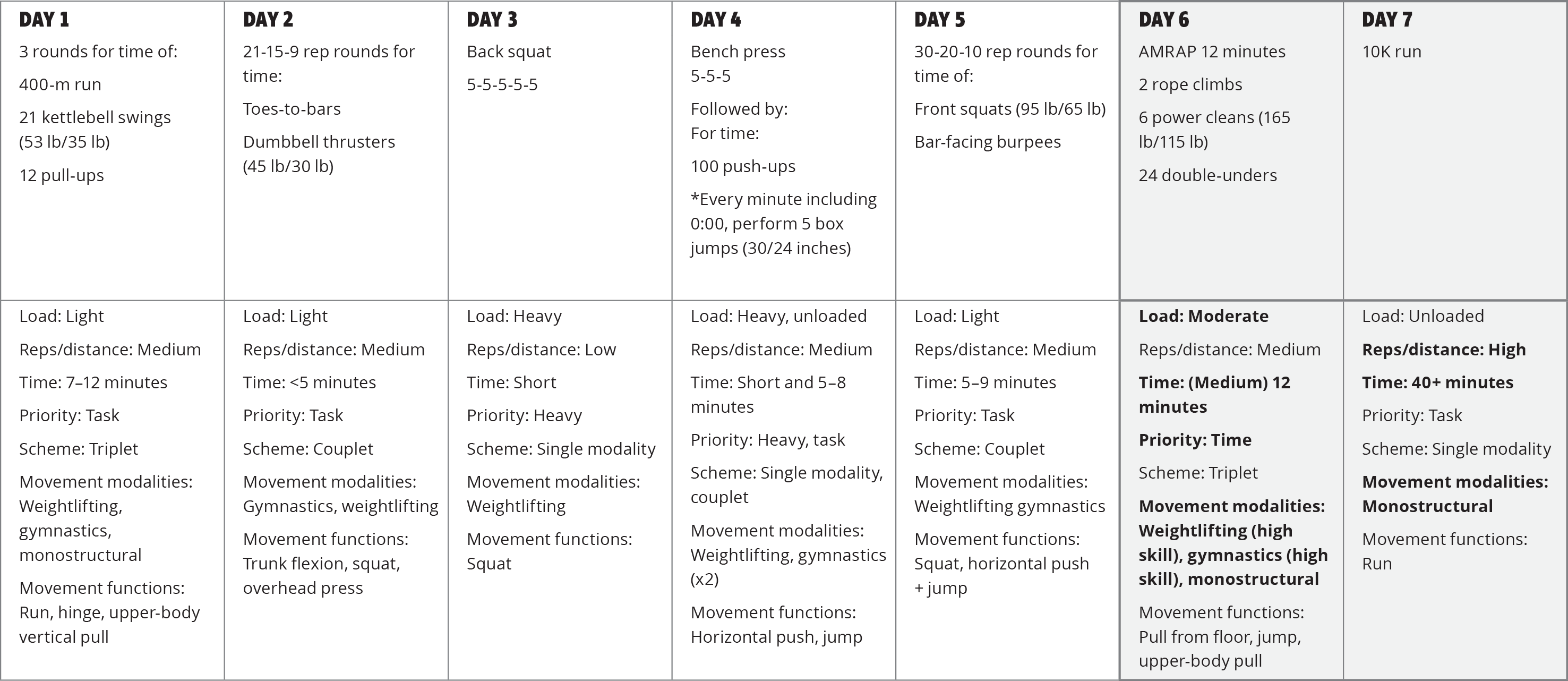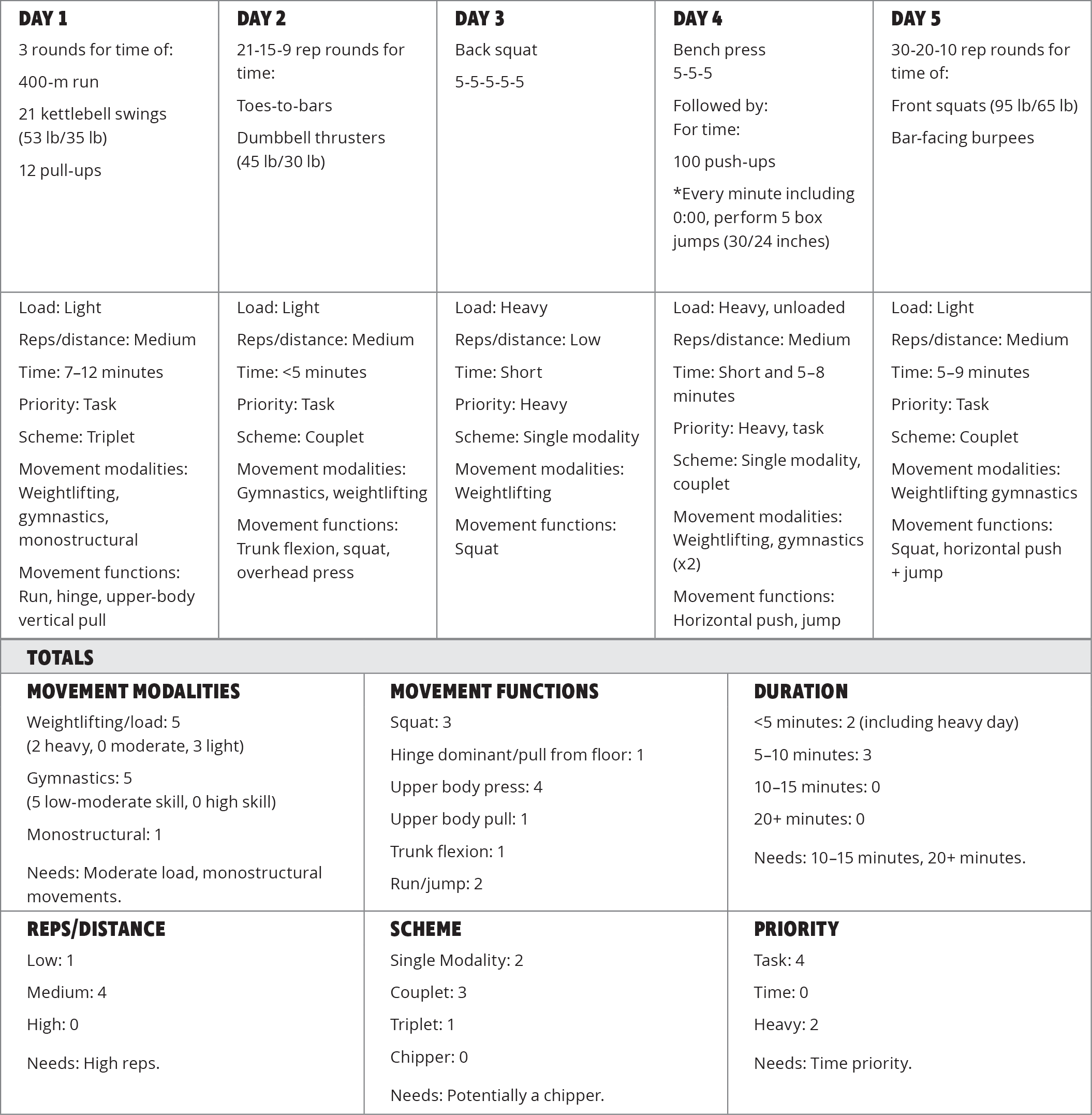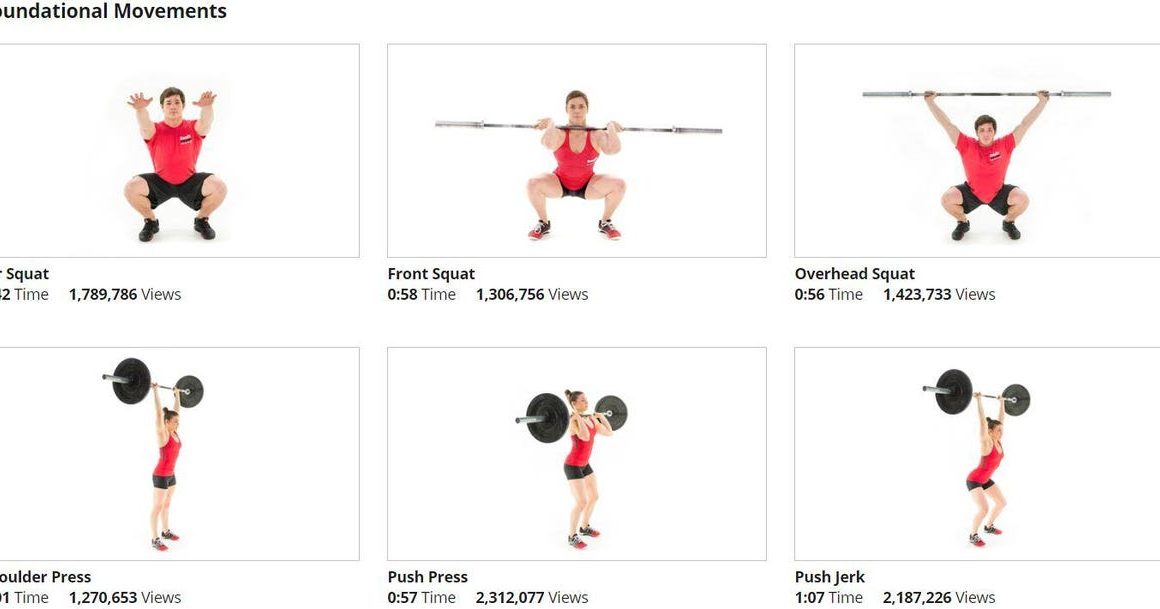Programming for Crossfit can seem daunting. It’s all about balance and effectiveness.
Crossfit blends strength, endurance, and skill training. To create a well-rounded program, you need to understand these elements. Each workout should have a clear purpose and target specific goals. Many athletes struggle with creating a Crossfit routine that maximizes results without causing burnout.
By learning the principles of Crossfit programming, you can design workouts that are safe, effective, and enjoyable. This guide will help you understand the basics, from setting goals to choosing exercises. Let’s dive into the essentials of Crossfit programming and how you can tailor your workouts to meet your fitness objectives.
Introduction To Crossfit Programming

Creating an effective Crossfit program requires a good understanding of its principles. This guide will introduce you to Crossfit programming, from its core concepts to the benefits it offers. By the end, you’ll have a clear idea of how to design a program that fits your needs.
What Is Crossfit?
Crossfit is a high-intensity fitness regimen that combines various types of exercise. It includes:
- Weightlifting
- Aerobic exercises
- Gymnastics
It aims to improve overall fitness by working on multiple fitness domains. These domains include:
- Strength
- Endurance
- Flexibility
Crossfit workouts are often short, intense, and varied. This variety keeps the workouts interesting and challenging.
Benefits Of Crossfit
Crossfit offers numerous benefits. Here are some key advantages:
| Benefit | Description |
|---|---|
| Improved Overall Fitness | Combines different exercise types to enhance all fitness aspects. |
| Time Efficiency | Short, intense workouts save time while delivering results. |
| Community Support | Offers a strong sense of community, motivating members to push harder. |
Additionally, Crossfit can be tailored to all fitness levels. Whether you’re a beginner or an athlete, you can adjust the workouts to match your abilities. This makes it accessible to a wide range of people.
Setting Goals
Setting goals is crucial for a successful CrossFit program. Goals give you direction and help measure progress. They keep you motivated and focused. It’s important to set both short-term and long-term goals. This ensures you are continually improving and staying on track. Below, we will discuss how to set effective short-term and long-term goals for your CrossFit journey.
Short-term Goals
Short-term goals are targets you aim to achieve in a few weeks or months. These goals should be specific and achievable. They provide quick wins and keep you motivated.
- Example 1: Improve your deadlift by 10 pounds in one month.
- Example 2: Complete a workout in under 20 minutes.
- Example 3: Master a specific movement, like the pull-up.
Tracking your progress is key. Use a fitness journal or an app to record your achievements. Celebrate small successes to stay motivated.
Long-term Goals
Long-term goals are objectives you aim to achieve in six months or more. These goals are more challenging and require sustained effort. They help you stay committed to your CrossFit program.
- Example 1: Compete in a CrossFit competition.
- Example 2: Increase overall strength by 20% in a year.
- Example 3: Improve cardiovascular endurance significantly.
Break down long-term goals into smaller milestones. This makes them more manageable. Regularly review and adjust your goals as needed. Stay flexible and adapt to changes in your fitness journey.
Understanding The Basics
Understanding the basics of programming for CrossFit is crucial for beginners. It helps in creating a solid foundation for your workouts. This section will cover the essentials like functional movements and intensity scaling. These are key concepts to start your CrossFit journey.
Functional Movements
Functional movements are the core of CrossFit. They mimic everyday actions. Think of squatting, lifting, or pushing. These exercises use multiple muscle groups. This makes your body stronger and more efficient. Start with basic movements. Then gradually add complexity. This approach reduces the risk of injury. It also ensures steady progress.
Intensity And Scaling
Intensity in CrossFit refers to how hard you work. It’s important to push yourself. But it’s equally vital to know your limits. This is where scaling comes in. Scaling adjusts the workout to your fitness level. It can mean reducing weights or modifying exercises. This way, you can perform the workout safely. Over time, you will build strength and endurance. Your intensity will naturally increase. Remember, consistency is key. Keep challenging yourself within your limits.
Creating A Balanced Program
Creating a balanced program for CrossFit ensures all-around fitness. This includes strength, cardiovascular conditioning, flexibility, and rest. A well-rounded approach helps prevent injuries and promotes consistent progress.
Strength Training
Strength training is the backbone of CrossFit. It builds muscle mass, enhances endurance, and improves overall performance. Focus on compound movements like:
- Squats
- Deadlifts
- Presses
- Pull-ups
- Cleans
These exercises target multiple muscle groups and burn more calories. Incorporate different rep ranges and weights to keep the muscles guessing. A typical strength training schedule might look like this:
| Day | Exercise | Reps | Sets |
|---|---|---|---|
| Monday | Squats | 5 | 5 |
| Wednesday | Deadlifts | 3 | 5 |
| Friday | Presses | 8 | 4 |
Rest between sets to allow muscle recovery. Keep track of your progress and adjust weights as needed.
Cardiovascular Conditioning
Cardiovascular conditioning is vital for heart health and stamina. It helps you perform high-intensity workouts without fatigue. Incorporate activities such as:
- Running
- Rowing
- Jump rope
- High-intensity interval training (HIIT)
These exercises boost your heart rate and burn calories. A balanced CrossFit program includes varied cardio workouts. Here’s a sample cardio schedule:
| Day | Activity | Duration |
|---|---|---|
| Tuesday | Running | 30 minutes |
| Thursday | Rowing | 20 minutes |
| Saturday | HIIT | 15 minutes |
Mix short, intense sessions with longer, steady-state cardio. This approach keeps workouts interesting and effective.
Incorporating Mobility And Recovery
Incorporating mobility and recovery is essential for any Crossfit program. It helps prevent injuries, enhances performance, and speeds up recovery. Mobility and recovery should be part of your daily routine. This ensures your body stays flexible and strong. Proper stretching and adequate rest are key components of a successful program.
Stretching Techniques
Effective stretching techniques can improve your range of motion. They also reduce muscle stiffness. Dynamic stretching involves active movements that take joints through their full range of motion. Examples include leg swings, arm circles, and torso twists. These stretches are great before a workout.
Static stretching involves holding a stretch for 15-60 seconds. This helps lengthen muscles and improve flexibility. Examples include hamstring stretches, calf stretches, and shoulder stretches. These are best done after your workout or during cool-down.
Rest Days
Rest days are critical for muscle recovery and growth. They allow your body to repair and strengthen itself. Without rest, you risk overtraining and injury. Plan at least one rest day per week. On rest days, focus on light activities such as walking or yoga. This keeps your body moving without strain.
Listen to your body. If you feel overly sore or fatigued, take an extra rest day. Proper rest balances intense training and keeps you performing at your best.
Nutrition For Peak Performance
To excel in CrossFit, nutrition is key. Proper nutrition fuels your workouts, aids recovery, and enhances performance. Understanding the right balance of nutrients helps you perform at your best. This section will cover macronutrients and hydration.
Macronutrients
Macronutrients are the main nutrients required by your body. They include carbohydrates, proteins, and fats. Each plays a crucial role in energy and muscle repair.
| Macronutrient | Function | Sources |
|---|---|---|
| Carbohydrates | Provide energy for workouts | Whole grains, fruits, vegetables |
| Proteins | Repair and build muscles | Lean meats, beans, nuts |
| Fats | Sustain energy, support cell function | Avocados, olive oil, nuts |
Balancing these macronutrients is vital. Aim for a mix of carbs, proteins, and fats in your meals. This ensures steady energy and proper recovery.
Hydration
Hydration is essential for peak performance. Water regulates body temperature and lubricates joints. It helps transport nutrients to give you energy and keep you healthy.
- Drink water before, during, and after workouts.
- Aim for at least 8 cups of water per day.
- Monitor your urine color. Light yellow indicates good hydration.
Electrolytes are also important. They help maintain fluid balance and muscle function. Include sources like bananas, coconut water, and sports drinks.
Proper hydration supports your overall health and enhances your CrossFit performance. Stay consistent with your water intake for the best results.
Tracking Progress
Tracking progress is essential for anyone involved in CrossFit. It helps you see improvements and identify areas needing attention. Consistent tracking ensures you stay motivated and focused on your fitness goals.
Logging Workouts
One effective way to track your progress is by logging workouts. Keep a detailed record of your daily exercises. Include information such as:
- Date of the workout
- Type of workout (e.g., WOD, strength training)
- Exercises performed
- Reps and sets
- Weights used
- Time taken to complete the workout
This data helps you see patterns and measure improvements over time. Use a notebook, app, or spreadsheet to keep everything organized.
Evaluating Performance
After logging your workouts, take time to evaluate your performance. Look at the data to find trends and track progress.
- Review your logs weekly or monthly.
- Identify areas where you have improved.
- Note any exercises where you struggle.
Regular evaluation helps you understand your strengths and weaknesses. It allows you to adjust your training program accordingly.
Consider these questions during evaluation:
- Are you lifting heavier weights?
- Is your workout time getting faster?
- Do you feel less fatigued after workouts?
Answering these questions helps you gauge your progress and stay motivated.
Avoiding Common Mistakes
When programming for Crossfit, avoiding common mistakes ensures better results and reduces injury risk. Proper planning and attention to detail are crucial. Below, we discuss two key areas: Overtraining and Ignoring Form.
Overtraining
Overtraining is a major issue in Crossfit. Many athletes push too hard, thinking more is better. But this can lead to burnout and injuries.
Here are some signs of overtraining:
- Constant fatigue
- Poor performance
- Increased injuries
To avoid overtraining, follow these steps:
- Plan rest days
- Monitor your body’s signals
- Include variety in workouts
Rest days are as important as training days. They help your muscles recover and grow. Listen to your body. If you feel too tired, take a break. Vary your workouts. Mix cardio, strength, and flexibility exercises.
Ignoring Form
Ignoring form is another common mistake. Good form prevents injuries and improves performance. Bad form can cause serious harm.
Here are some tips to maintain good form:
- Start with lighter weights
- Focus on technique
- Get feedback from a coach
Start with lighter weights to learn the correct movements. Focus on your technique. Don’t rush through exercises. Seek feedback from a coach or experienced athlete. They can help correct mistakes and improve your form.
Here’s a table summarizing the key points:
| Common Mistake | Solution |
|---|---|
| Overtraining | Plan rest days, monitor your body, include variety |
| Ignoring Form | Start with lighter weights, focus on technique, get feedback |
Avoiding these common mistakes will help you stay healthy and improve your Crossfit performance.
Adapting The Program
Adapting a CrossFit program is essential for achieving personal fitness goals. Each athlete has unique needs and limitations. By tailoring workouts, you can ensure progress and prevent injuries. This section will explore customizing workouts and handling injuries.
Customizing Workouts
Every athlete has different strengths and weaknesses. Customize workouts to target specific areas. Adjust the intensity and volume based on individual fitness levels. Use scaling options to modify exercises. This helps maintain proper form and prevent overexertion. Listen to your body and make necessary changes.
Incorporate a variety of movements. This keeps the workouts interesting. It also works on different muscle groups. Balance strength training with cardio and flexibility exercises. Ensure a well-rounded fitness routine. Track progress and adjust the program as needed.
Handling Injuries
Injuries can occur during intense workouts. Address them immediately to prevent further damage. Modify exercises to avoid aggravating the injury. Focus on movements that do not cause pain. Strengthen the injured area through rehabilitation exercises. This helps in faster recovery.
Consult a medical professional for advice. Follow their recommendations for treatment and recovery. Rest and allow time for healing. Gradually ease back into the workout routine. Prioritize long-term health over short-term gains.

Credit: www.crossfit.com

Credit: www.crossfit.com
Frequently Asked Questions
What Is Crossfit Programming?
CrossFit programming involves designing workouts that improve strength, endurance, and flexibility. It includes a mix of weightlifting, cardio, and bodyweight exercises. The goal is to enhance overall fitness.
How To Start Programming For Crossfit?
Start by assessing your current fitness level. Incorporate a variety of exercises. Gradually increase intensity and complexity. Ensure balanced workouts to target all muscle groups.
How Often Should I Program Crossfit Workouts?
Aim for at least three to five sessions per week. Ensure to include rest days. This helps in recovery and prevents injury.
What Are The Key Elements Of Crossfit Programming?
Key elements include variety, intensity, and functional movements. Workouts should be scalable and adaptable. This ensures inclusivity for all fitness levels.
Conclusion
Creating a successful CrossFit program involves careful planning and understanding your goals. Focus on varied workouts to build strength, endurance, and flexibility. Consistency is key. Listen to your body and avoid injuries by not overtraining. Seek guidance from experienced coaches when needed.
Always remember, progress takes time. Stay dedicated and enjoy the journey. CrossFit can be challenging, but it is also rewarding. With the right approach, you will see great results. Keep pushing your limits and stay committed. Your hard work will pay off.


